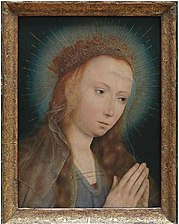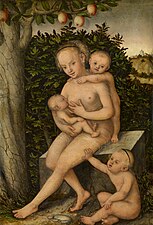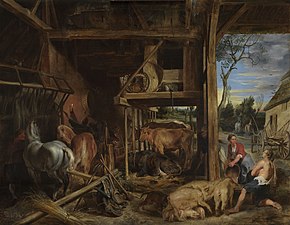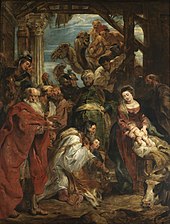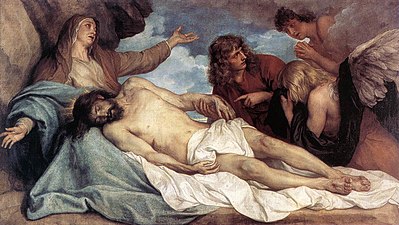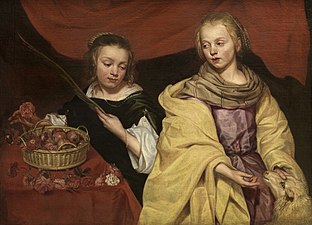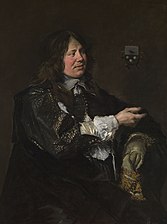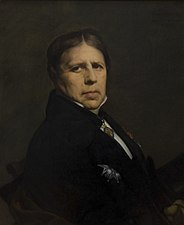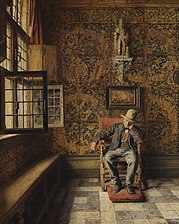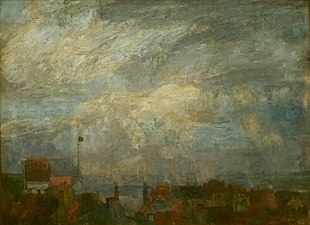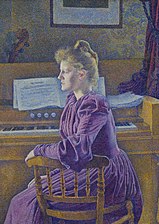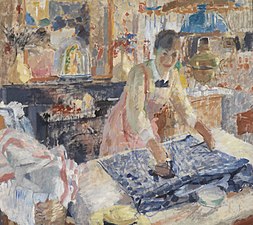
Quentin Matsys (1466–1530) was a Flemish painter in the Early Netherlandish tradition. He was born in Leuven. According to tradition, he trained as an ironsmith before becoming a painter. Matsys was active in Antwerp for over 20 years, creating numerous works with religious roots and satirical tendencies. He is regarded as the founder of the Antwerp school of painting, which became the leading school of painting in Flanders in the 16th century. He introduced new techniques and motifs as well as moralising subjects without completely breaking with tradition.

Hans Memling was a German-Flemish painter who worked in the tradition of Early Netherlandish painting. Born in the Middle Rhine region, he probably spent his childhood in Mainz. During his apprenticeship as a painter he moved to the Netherlands and spent time in the Brussels workshop of Rogier van der Weyden. In 1465 he was made a citizen of Bruges, where he became one of the leading artists and the master of a large workshop. A tax document from 1480 lists him among the wealthiest citizens. Memling's religious works often incorporated donor portraits of the clergymen, aristocrats, and burghers who were his patrons. These portraits built upon the styles which Memling learned in his youth.
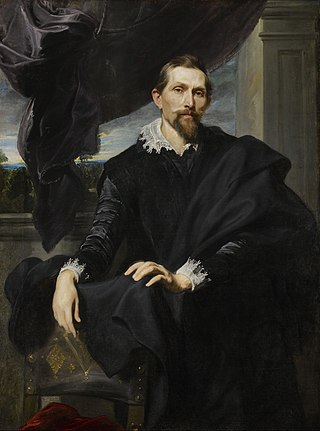
Frans Snyders or Frans Snijders was a Flemish painter of animals, hunting scenes, market scenes, and still lifes. A versatile artist, his works depict all sorts of foods, utensils, and tableware and wide assortment of animals. He was one of the earliest specialist animaliers and he is credited with initiating a wide variety of new still-life and animal subjects in Antwerp. His hunting scenes and still lifes engage the viewer with their dramatic and dynamic effects. He was a regular collaborator with leading Antwerp painters such as Peter Paul Rubens, Anthony van Dyck, Jacob Jordaens, and Abraham Janssens.

Early Netherlandish painting is the body of work by artists active in the Burgundian and Habsburg Netherlands during the 15th- and 16th-century Northern Renaissance period, once known as the Flemish Primitives. It flourished especially in the cities of Bruges, Ghent, Mechelen, Leuven, Tournai and Brussels, all in present-day Belgium. The period begins approximately with Robert Campin and Jan van Eyck in the 1420s and lasts at least until the death of Gerard David in 1523, although many scholars extend it to the beginning of the Dutch Revolt in 1566 or 1568–Max J. Friedländer's acclaimed surveys run through Pieter Bruegel the Elder. Early Netherlandish painting coincides with the Early and High Italian Renaissance, but the early period is seen as an independent artistic evolution, separate from the Renaissance humanism that characterised developments in Italy. Beginning in the 1490s, as increasing numbers of Netherlandish and other Northern painters traveled to Italy, Renaissance ideals and painting styles were incorporated into northern painting. As a result, Early Netherlandish painters are often categorised as belonging to both the Northern Renaissance and the Late or International Gothic.
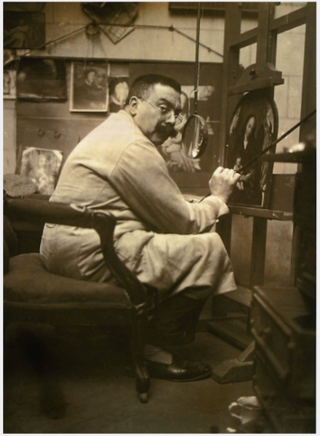
Josephus Maria Van der Veken was a Belgian art restorer, copyist, and art forger who mastered the art of reproducing the works of early Netherlandish painters.

Petrus Christus was an Early Netherlandish painter active in Bruges from 1444, where, along with Hans Memling, he became the leading painter after the death of Jan van Eyck. He was influenced by van Eyck and Rogier van der Weyden and is noted for his innovations with linear perspective and a meticulous technique which seems derived from miniatures and manuscript illumination. Today, some 30 works are confidently attributed to him. The best known include the Portrait of a Carthusian (1446) and Portrait of a Young Girl ; both are highly innovative in the presentation of the figure against detailed, rather than flat, backgrounds.

The Thyssen-Bornemisza National Museum, or simply the Thyssen, is an art museum in Madrid, Spain, located near the Prado Museum on one of the city's main boulevards. It is known as part of the "Golden Triangle of Art", which also includes the Prado and the Reina Sofía national galleries. The Thyssen-Bornemisza fills the historical gaps in its counterparts' collections: in the Prado's case this includes Italian primitives and works from the English, Dutch and German schools, while in the case of the Reina Sofía it concerns Impressionists, Expressionists, and European and American paintings from the 20th century.
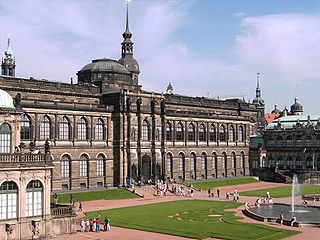
The Gemäldegalerie Alte Meister in Dresden, Germany, displays around 750 paintings from the 15th to the 18th centuries. It includes major Italian Renaissance works as well as Dutch and Flemish paintings. Outstanding works by German, French, and Spanish painters of the period are also among the gallery's attractions.

Flemish painting flourished from the early 15th century until the 17th century, gradually becoming distinct from the painting of the rest of the Low Countries, especially the modern Netherlands. In the early period, up to about 1520, the painting of the whole area is typically considered as a whole, as Early Netherlandish painting. This was dominated by the Flemish south, but painters from the north were also important. Dutch and Flemish Renaissance painting, of which Antwerp became the centre, covers the period up to about 1580 or later, by the end of which the north and south Netherlands had become politically separated. Flemish Baroque painting was especially important in the first half of the 17th century, dominated by Rubens.

Hieronymus Cock, or Hieronymus Wellens de Cock was a Flemish painter and etcher as well as a publisher and distributor of prints. Cock is regarded as one of the most important print publishers of his time in northern Europe. His publishing house played a key role in the transformation of printmaking from an activity of individual artists and craftsmen into an industry based on division of labour. His house published more than 1,100 prints between 1548 and his death in 1570, a vast number by earlier standards.
The Antwerp School was a school of artists active in Antwerp, first during the 16th century when the city was the economic center of the Low Countries, and then during the 17th century when it became the artistic stronghold of the Flemish Baroque under Peter Paul Rubens.

The Savoy Gallery is an art collection in the Italian city of Turin, which contains the royal art collections amassed by the House of Savoy over the centuries. It is located on Via XX Settembre, 86.
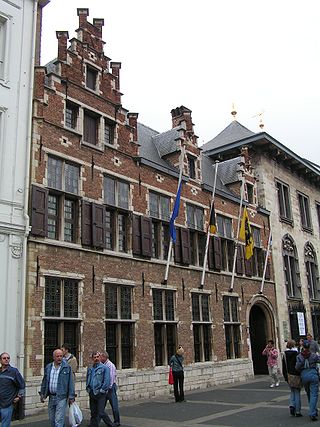
The Rubenshuis is the former home and workshop of Peter Paul Rubens (1577–1640) in Antwerp. Purchased in 1610, Rubens had the Flemish townhouse renovated and extended on the basis of designs by Rubens himself. After the renovations, the house and its courtyard garden had the outlook of an Italian palazzo, which reflected the artistic ideals of Rubens. The ensemble is now a museum dedicated mainly to the work of Rubens and his contemporaries.

The art of the Low Countries consists of painting, sculpture, architecture, printmaking, pottery, and other forms of visual art produced in the Low Countries, and since the 19th century in Belgium in the southern Netherlands and the Netherlands in the north.

The Seven Sacraments Altarpiece is a fixed-wing triptych by the Early Netherlandish artist Rogier van der Weyden and his workshop. It was painted from 1445 to 1450, probably for a church in Poligny, and is now in the Royal Museum of Fine Arts, Antwerp. It depicts the seven sacraments of the Roman Catholic Church. On the left panel are baptism, confirmation and confession and on the right hand panel the ordination of a priest, marriage and the last rites.
Despite its size, Belgium has a long and distinguished artistic tradition that goes back to the Middle Ages, considerably pre-dating the foundation of the current state in 1830. Art from the areas making up modern Belgium is called in English Netherlandish up to the separation with the Netherlands from 1570 on, and Flemish until the 18th century.
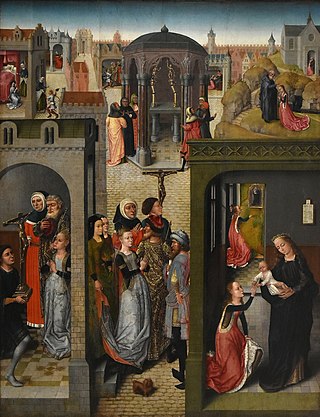
The Master of the Legend of Saint Catherine is the notname for an unknown late 15th century Early Netherlandish painter. He was named after a painting with Scenes from the Legend of Saint Catherine, now kept in the Royal Museums of Fine Arts of Belgium. He was active between c. 1470 and c. 1500, probably around Brussels.

The Oldmasters Museum is an art museum in the Royal Quarter of Brussels, Belgium, dedicated to Old Master European painters of the 15th to the 18th centuries, with some later works. It is one of the constituent museums of the Royal Museums of Fine Arts of Belgium.

The Phoebus Foundation is an art foundation with philanthropic objectives. The foundation acquires works of art, guarantees a professional framework of conservation and management, and looks after the conservation and restoration of the objects. In doing so, it focuses on scientific research. It shares the results of this all with the widest possible audience, through exhibitions, cultural expeditions, symposiums and publications.
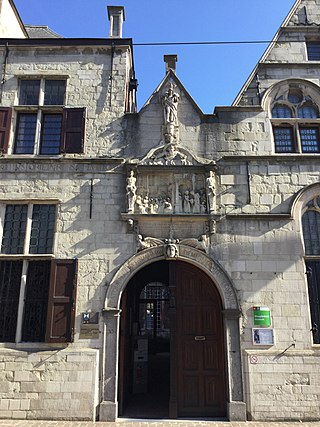
The Maagdenhuis Museum is an art museum and historical museum located in a 17th-century historic building on Lange Gasthuisstraat, Antwerp, Belgium. The building was used as an orphanage for the maegdeckens, or maidens, from the mid-16th century to the end of the 19th century. The museum presents a collection of utensils used daily by the foundlings and the orphans; a collection of antique furniture, and a series of documents relating to the orphanage and the life in it from the 16th century to 19th century.









